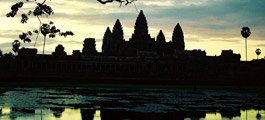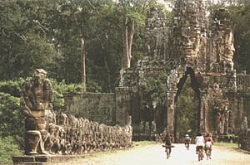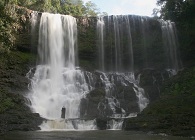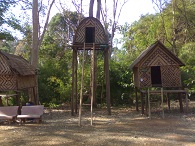
 Angkor Wat, in its beauty and state of preservation, is unrivaled. Its mightiness and magnificence bespeak a pomp and a luxury surpassing that of a Pharaoh or a Shah Jahan, an impressiveness greater than that of the Pyramids, an artistic distinctiveness as fine as that of the Taj Mahal. Angkor Wat is located about six kilometers (four miles) north of Siem Reap, south of Angkor Thom. Entry and exit to Angkor Wat can only be access from its west gate. Angkor Wat was built in the first half of the 12th century (113-5BC). Estimated construction time of the temple is 30 years by King Suryavarman II, dedicated to Vishnu (Hindu), replica of Angkor Thom style of art.
Angkor Wat, in its beauty and state of preservation, is unrivaled. Its mightiness and magnificence bespeak a pomp and a luxury surpassing that of a Pharaoh or a Shah Jahan, an impressiveness greater than that of the Pyramids, an artistic distinctiveness as fine as that of the Taj Mahal. Angkor Wat is located about six kilometers (four miles) north of Siem Reap, south of Angkor Thom. Entry and exit to Angkor Wat can only be access from its west gate. Angkor Wat was built in the first half of the 12th century (113-5BC). Estimated construction time of the temple is 30 years by King Suryavarman II, dedicated to Vishnu (Hindu), replica of Angkor Thom style of art..jpg) Angkor Wat, the largest monument of the Angkor group and the best preserved, was listed in World Wonder List
and is an architectural masterpiece. Its perfection in composition, balance, proportions, relief's and sculpture make it one of the finest monuments in the world.Wat is the Khmer name for temple (the French spelling is "vat "), which was probably added to "Angkor "when it became a Theravada Buddhist monument, most likely in the sixteenth century. After 1432 when the capital moved to Phnom Penh, Angkor Wat was cared for by Buddhist monks.It is generally accepted that Angkor Wat was a funerary temple for King Suryavarman II and oriented to the west to conform to the symbolism between the setting sun and death. The bas-reliefs, designed for viewing from left to right in the order of Hindu funereal ritual, support this function.
Angkor thom
Angkor Thom is undeniably an expression of the highest genius. It is, in three dimensions and on a scale worthy of an entire nation, the materialization of Buddhist cosmology, representing ideas that only great painters would dare to portray.
Angkor Wat, the largest monument of the Angkor group and the best preserved, was listed in World Wonder List
and is an architectural masterpiece. Its perfection in composition, balance, proportions, relief's and sculpture make it one of the finest monuments in the world.Wat is the Khmer name for temple (the French spelling is "vat "), which was probably added to "Angkor "when it became a Theravada Buddhist monument, most likely in the sixteenth century. After 1432 when the capital moved to Phnom Penh, Angkor Wat was cared for by Buddhist monks.It is generally accepted that Angkor Wat was a funerary temple for King Suryavarman II and oriented to the west to conform to the symbolism between the setting sun and death. The bas-reliefs, designed for viewing from left to right in the order of Hindu funereal ritual, support this function.
Angkor thom
Angkor Thom is undeniably an expression of the highest genius. It is, in three dimensions and on a scale worthy of an entire nation, the materialization of Buddhist cosmology, representing ideas that only great painters would dare to portray.Angkor Wat lies 5.5 kilometres (3.4 mi) north of the modern town of Siem Reap, and a short distance south and slightly east of the previous capital, which was centred at Baphuon. It is in an area of Cambodia where there is an important group of ancient structures. It is the southernmost of Angkor's main sites. The initial design and construction of the temple took place in the first half of the 12th century, during the reign of Suryavarman II (ruled 1113 – c. 1150).
 Dedicated to Vishnu, it was built as the king's state temple and capital city. As neither the foundation stela nor any contemporary inscriptions referring to the temple have been found, its original name is unknown, but it may have been known as Vrah Vishnu-lok ( literally "Holy Vishnu'-Location'", Old Khmer' Cl. Sanskrit). after the presiding deity. Work seems to have ended shortly after the king's death, leaving some of the bas-relief decoration unfinished.[5] In 1177, approximately 27 years after the death of Suryavarman II, Angkor was sacked by the Chams, the traditional enemies of the Khmer. Thereafter the empire was restored by a new king, Jayavarman VII, who established a new capital and state temple (Angkor Thom and the Bayon respectively) a few kilometres to the north.
In the late 13th century, Angkor Wat gradually moved from Hindu to Theravada Buddhist use, which continues to the present day. Angkor Wat is unusual among the Angkor temples in that although it was somewhat neglected after the 16th century it was never completely abandoned, its preservation being due in part to the fact that its moat also provided some protection from encroachment by the jungle.[6]
One of the first Western visitors to the temple was António da Madalena, a Portuguese monk who visited in 1586 and said that it "is of such extraordinary construction that it is not possible to describe it with a pen, particularly since it is like no other building in the world. It has towers and decoration and all the refinements which the human genius can conceive of."[7] In the mid 19th century the temple was visited by the French naturalist and explorer, Henri Mouhot, who popularised the site in the West through the publication of travel notes, in which he wrote:
"One of these temples—a rival to that of Solomon, and erected by some ancient Michelangelo—might take an honourable place beside our most beautiful buildings. It is grander than anything left to us by Greece or Rome, and presents a sad contrast to the state of barbarism in which the nation is now plunged.
Dedicated to Vishnu, it was built as the king's state temple and capital city. As neither the foundation stela nor any contemporary inscriptions referring to the temple have been found, its original name is unknown, but it may have been known as Vrah Vishnu-lok ( literally "Holy Vishnu'-Location'", Old Khmer' Cl. Sanskrit). after the presiding deity. Work seems to have ended shortly after the king's death, leaving some of the bas-relief decoration unfinished.[5] In 1177, approximately 27 years after the death of Suryavarman II, Angkor was sacked by the Chams, the traditional enemies of the Khmer. Thereafter the empire was restored by a new king, Jayavarman VII, who established a new capital and state temple (Angkor Thom and the Bayon respectively) a few kilometres to the north.
In the late 13th century, Angkor Wat gradually moved from Hindu to Theravada Buddhist use, which continues to the present day. Angkor Wat is unusual among the Angkor temples in that although it was somewhat neglected after the 16th century it was never completely abandoned, its preservation being due in part to the fact that its moat also provided some protection from encroachment by the jungle.[6]
One of the first Western visitors to the temple was António da Madalena, a Portuguese monk who visited in 1586 and said that it "is of such extraordinary construction that it is not possible to describe it with a pen, particularly since it is like no other building in the world. It has towers and decoration and all the refinements which the human genius can conceive of."[7] In the mid 19th century the temple was visited by the French naturalist and explorer, Henri Mouhot, who popularised the site in the West through the publication of travel notes, in which he wrote:
"One of these temples—a rival to that of Solomon, and erected by some ancient Michelangelo—might take an honourable place beside our most beautiful buildings. It is grander than anything left to us by Greece or Rome, and presents a sad contrast to the state of barbarism in which the nation is now plunged.
 Angkor Thom, the last capital of the Khmer Empire, was a fortified cit enclosing residences of priest, officials of the palace and military, as well as buildings for administering the kingdom.
These structures were built of wood and have perished but the remaining stone monuments testify that Angkor Thom was indeed a "Great City" as its name implies. Temples inside the walls of the city described in this article are Bayon, Phimeanakas, Baphuon, Terrace of the Elephants, Terrace of the Leper King, Prah Palilay, Tep Pranam and Prasat Suor Prat.
The Royal Palace situated within the city of Angkor Thom is of an earlier date and belonged to kings of the tenth and first half of the tenth and first half of the eleventh centuries. Although the foundations and an enclosing wall around the palace with entry towers have been identified, little evidence remains of the layout of the buildings inside the enclosure. This absence of archaeological evidence of the royal buildings suggests that they were constructed of wood and have perished.
The French ascertained a general plan of the Royal Palace (see map opposite). It included the temple-mountain of Phimeanakas and surrounding pools together with residences and buildings for administering the capital, which were probably at the back of the enclosure. Jayavarman VII reconstructed the original site of the Royal Palace Palace to erect the city of Angkor Thom, which was centered on the temple of Bayon and surrounded by a wall. Zhou Daguan the Chinese emissary, who provided the only first-hand account o f the Khmer, described the splendor of Angkor Thom.
At the center of the Kingdom rises a Golden tower Bayon flanked by more than twenty lesser towers and several hundred stone chambers. On the eastern side is a golden bridge guarded by two lions of gold, one on each side, with eight golden Buddhas spaced along the stone chambers. North of the Golden Tower of Bronze [Baphuon], higher even than the Golden tower. a truly astonishing spectacle. With more than ten chambers at its base. A quarter of a mile further north is the residence of the King rising above his private apartments is another tower of gold, These are the monuments which have caused merchants from overseas to speak so often of "Cambodia the rich and noble." Byon We stand before it stunned. It is like nothing else in the land.
Angkor Thom, the last capital of the Khmer Empire, was a fortified cit enclosing residences of priest, officials of the palace and military, as well as buildings for administering the kingdom.
These structures were built of wood and have perished but the remaining stone monuments testify that Angkor Thom was indeed a "Great City" as its name implies. Temples inside the walls of the city described in this article are Bayon, Phimeanakas, Baphuon, Terrace of the Elephants, Terrace of the Leper King, Prah Palilay, Tep Pranam and Prasat Suor Prat.
The Royal Palace situated within the city of Angkor Thom is of an earlier date and belonged to kings of the tenth and first half of the tenth and first half of the eleventh centuries. Although the foundations and an enclosing wall around the palace with entry towers have been identified, little evidence remains of the layout of the buildings inside the enclosure. This absence of archaeological evidence of the royal buildings suggests that they were constructed of wood and have perished.
The French ascertained a general plan of the Royal Palace (see map opposite). It included the temple-mountain of Phimeanakas and surrounding pools together with residences and buildings for administering the capital, which were probably at the back of the enclosure. Jayavarman VII reconstructed the original site of the Royal Palace Palace to erect the city of Angkor Thom, which was centered on the temple of Bayon and surrounded by a wall. Zhou Daguan the Chinese emissary, who provided the only first-hand account o f the Khmer, described the splendor of Angkor Thom.
At the center of the Kingdom rises a Golden tower Bayon flanked by more than twenty lesser towers and several hundred stone chambers. On the eastern side is a golden bridge guarded by two lions of gold, one on each side, with eight golden Buddhas spaced along the stone chambers. North of the Golden Tower of Bronze [Baphuon], higher even than the Golden tower. a truly astonishing spectacle. With more than ten chambers at its base. A quarter of a mile further north is the residence of the King rising above his private apartments is another tower of gold, These are the monuments which have caused merchants from overseas to speak so often of "Cambodia the rich and noble." Byon We stand before it stunned. It is like nothing else in the land.
 The Bayon is located in the center of the city of Angkor Thom 1500 meters (4921 feet) from the south gate. Enter tower of the Bayon is from the east. Prasat Bayon was built in late 12th century to early 13th century, by the King Jayavarman VII, dedicated to Buddhist. The Bayon vies with Angkor Wat the favorite monument of visitors. the two evoke similar aesthetic responses yet are different in purpose, design, architecture and decoration. The dense jungle surround the temple camouflaged its position in relation to other structures at Angkor so it was not known for some time that the Bayon stands in the exact centre of the city of Angkor Thom.
Even after this was known, the Bayon was erroneously connected with the city of Yasovarman I and thus dated to the ninth century. A pediment found in 1925 depicting an Avalokitesvara identified the Bayon as a Buddhist temple.
This discovery moved the date of the monument ahead some 300 years to the late twelfth century. Even though the date is firmly implanted and supported by archaeological evidence, the Bayon remains one of the most enigmatic temples of the Angkor group. Its symbolism, original form and subsequent changes and constructions have not yet been untangled.
The Bayon was built nearly 100 years after Angkor Wat. The basic structure and earliest part of the temple ate not known. Since it was located at the centre of a royal city it seems possible that the Bayon would have originally been a temple-mountain conforming to the symbolism of a microcosm of Mount Meru. The middle part of the temple was extended during the second phase of building. The Bayon of today belong to the third and last phase of the art style. The architectural scale and composition of the Bayon exude grandness in every aspects. Its elements juxtapose each other to create balance and harmony.
Over 2000 large faces carved on the 54 tower give this temple its majestic character. The faces with slightly curving lips, eyes placed in shadow by the lowered lids utter not a word and yet force you to guess much, wrote P Jennerat de Beerski in the 1920s. It is generally accepted that four faces on each of the tower are images of the bodhisattva Avalokitesvara and that they signify the omnipresence of the king. The characteristics of this faces - a broad forehead, downcast eyes, wild nostrils, thick lips that curl upwards slightly at the ends-combine to reflect the famous 'Smile of Angkor'.
The Bayon is located in the center of the city of Angkor Thom 1500 meters (4921 feet) from the south gate. Enter tower of the Bayon is from the east. Prasat Bayon was built in late 12th century to early 13th century, by the King Jayavarman VII, dedicated to Buddhist. The Bayon vies with Angkor Wat the favorite monument of visitors. the two evoke similar aesthetic responses yet are different in purpose, design, architecture and decoration. The dense jungle surround the temple camouflaged its position in relation to other structures at Angkor so it was not known for some time that the Bayon stands in the exact centre of the city of Angkor Thom.
Even after this was known, the Bayon was erroneously connected with the city of Yasovarman I and thus dated to the ninth century. A pediment found in 1925 depicting an Avalokitesvara identified the Bayon as a Buddhist temple.
This discovery moved the date of the monument ahead some 300 years to the late twelfth century. Even though the date is firmly implanted and supported by archaeological evidence, the Bayon remains one of the most enigmatic temples of the Angkor group. Its symbolism, original form and subsequent changes and constructions have not yet been untangled.
The Bayon was built nearly 100 years after Angkor Wat. The basic structure and earliest part of the temple ate not known. Since it was located at the centre of a royal city it seems possible that the Bayon would have originally been a temple-mountain conforming to the symbolism of a microcosm of Mount Meru. The middle part of the temple was extended during the second phase of building. The Bayon of today belong to the third and last phase of the art style. The architectural scale and composition of the Bayon exude grandness in every aspects. Its elements juxtapose each other to create balance and harmony.
Over 2000 large faces carved on the 54 tower give this temple its majestic character. The faces with slightly curving lips, eyes placed in shadow by the lowered lids utter not a word and yet force you to guess much, wrote P Jennerat de Beerski in the 1920s. It is generally accepted that four faces on each of the tower are images of the bodhisattva Avalokitesvara and that they signify the omnipresence of the king. The characteristics of this faces - a broad forehead, downcast eyes, wild nostrils, thick lips that curl upwards slightly at the ends-combine to reflect the famous 'Smile of Angkor'.
.jpg)
.jpg)
.jpg)
.jpg)
.jpg)
.jpg)


.jpg)
.jpg)

